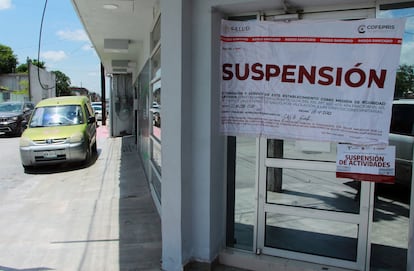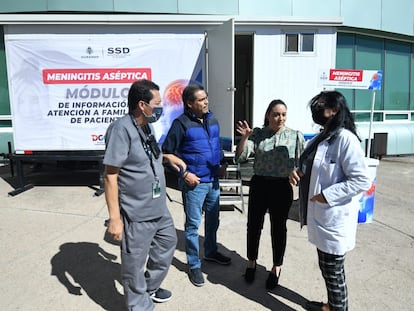Contaminated anesthetic suspected to be cause of Matamoros meningitis outbreak
At least one person has died after an outbreak similar to that seen in Durango. Mexico’s authorities have reported 23 cases, nine in U.S. patients and 14 in Mexicans


History appears to be repeating itself. Authorities in Mexico and the United States believe a contaminated anesthetic drug is behind a meningitis outbreak at two private clinics in Matamoros, Mexico, located close to the country’s border with the U.S. Both clinics, which specialize in cosmetic surgery, were closed on 13 May. Mexico’s Ministry of Health has reported 23 cases: nine involving American patients, and a further 14 infections among Mexican patients. One death has been confirmed in the U.S., where a second fatality potentially linked to the outbreak is being investigated. “Of the [Mexican] cases, four are suspected, with the patients showing symptoms,” the ministry said in a statement on Thursday. “Five are probable cases, with alterations present in the results of cerebrospinal fluid analysis, and a further five cases have been confirmed by the presence of the fungus Fusarium solani.”
The spate of cases in Matamoros bears significant similarities to the meningitis outbreak that began in October in Durango, Mexico, and has so far led to 39 confirmed deaths — 38 women and one man. In Durango, a local anesthetic known as bupivacaine was found to have been infected by the same fungus. The drug was chiefly used for short operations such as caesarean sections, which is why the overwhelming majority of those affected were young women. In Matamoros, the identity of the anesthetic involved has not emerged, but — as in Durango — authorities have revealed that the meningitis infections have occurred in patients who received a “spinal block for surgical procedures.”
Authorities are now trying to identify patients who were exposed to the anesthetic in the two Matamoros clinics, River Side Surgical Center and K-3. The government of Tamaulipas, the northeastern state in which the city is located, estimates that 547 people had operations in the two medical centers between 1 January and 13 May. This type of meningitis has a mortality rate that can exceed 50%, although a 2015 study found that the risk of death can drop to around 40% if infected patients are treated before they start showing symptoms. In preparation for the potential emergence of more cases, Mexico’s Ministry of Health is training health professionals at state hospitals both in Matamoros and the cities of Ciudad Victoria and Reynosa, which are also in Tamaulipas.
“Our full focus is on patients who are at risk and do not present symptoms, and those who have some type of alteration,” Tamaulipas’ state health minister, Vicente Hernández Navarro, said earlier this week. “Our aim is to provide them with diagnosis, medical care and treatment in a timely manner.” In Matamoros, affected patients are being referred to the Hospital General Doctor Alfredo Pumarejo and the Hospital General de Zona No. 13. Mexico’s Federal Commission for Protection against Healthcare Risks (Cofepris) is now investigating the drug believed to have caused the outbreak, and has also launched a probe into the two clinics involved.
“Unfortunately, yes, this situation has led to deaths,” Mexican President Andrés Manuel López Obrador said on Thursday. “It’s a drug used as an anesthetic in cosmetic surgery that was contaminated, that was discovered to be in a poor state. It was used by two private clinics in Matamoros and those affected are getting help. We have known about what is happening in Matamoros for two weeks. Dr. Hugo López Gatell [Mexico’s deputy health minister] is attending to the matter and a comprehensive investigation is being carried out.”
Authorities are following the roadmap adopted in Durango, which has sent medication to Matamoros to help combat the illness. In October, the medical community was facing an outbreak that was largely unprecedented; there was no established script for it to follow. In its most common form, meningitis is transmitted by a virus and leads to the inflammation of the membranes that envelop the brain and the spinal cord. But in Durango — and, seemingly, in Matamoros — infection has occurred differently, with the fungus injected directly into the spinal cord alongside the anesthetic. An expert consulted by EL PAÍS offered the following analogy: imagine if a city protects itself from invasion by building strong outer walls, only for the enemy to fly in and touch down right in its central square. This is why this type of meningitis has such a high mortality rate.
On 16 May, the U.S. government issued a warning after four of the country’s citizens contracted meningitis after traveling to Matamoros to undergo operations — a common practice in the States, as cosmetic surgery is much cheaper in Mexico. The U.S. Centers for Disease Control and Prevention (CDC) urged Americans to avoid operations in the city “until there is evidence that there is no longer a risk for infection.” At that juncture, the CDC was already pointing to epidural anesthesia as the potential cause. Indeed, it was the U.S. authorities that informed their Mexican counterparts of the meningitis outbreak, as Mexico’s Ministry of Health acknowledged on Thursday: “It should be noted that the Mexican government became aware of this event because of a communication by the CDC on 11 May 2023, in accordance with the International Health Regulations (IHR).”
After an extensive investigation into the outbreak that began in October, Mexican prosecutors determined that the anesthetic that caused the raft of meningitis cases in Durango had not been contaminated before arrival. Its manufacturer, pharmaceutical company Pisa, distributes it across the entire continent, but at that time there had only been cases in Durango. Instead, it was deemed that the outbreak had been brought about by hospitals’ poor handling of the drug.
However, in the wake of the spate of meningitis infections in Matamoros, the key question now is whether the conclusions reached in Durango, which were based on the premise that what had been witnessed were isolated cases, are still valid. It has not yet been revealed which pharmaceutical manufacturer produced the drug used in Matamoros.
Sign up for our weekly newsletter to get more English-language news coverage from EL PAÍS USA Edition
Tu suscripción se está usando en otro dispositivo
¿Quieres añadir otro usuario a tu suscripción?
Si continúas leyendo en este dispositivo, no se podrá leer en el otro.
FlechaTu suscripción se está usando en otro dispositivo y solo puedes acceder a EL PAÍS desde un dispositivo a la vez.
Si quieres compartir tu cuenta, cambia tu suscripción a la modalidad Premium, así podrás añadir otro usuario. Cada uno accederá con su propia cuenta de email, lo que os permitirá personalizar vuestra experiencia en EL PAÍS.
¿Tienes una suscripción de empresa? Accede aquí para contratar más cuentas.
En el caso de no saber quién está usando tu cuenta, te recomendamos cambiar tu contraseña aquí.
Si decides continuar compartiendo tu cuenta, este mensaje se mostrará en tu dispositivo y en el de la otra persona que está usando tu cuenta de forma indefinida, afectando a tu experiencia de lectura. Puedes consultar aquí los términos y condiciones de la suscripción digital.
More information
Archived In
Últimas noticias
There is as much life left to discover on planet Earth as that which is already known
Dozens presumed dead, around 100 injured in fire at Swiss Alps bar during New Year’s celebration
Is porn for women different from conventional porn? We spoke to those who make it
Cartagena de Indias is sinking: What can the city do to mitigate it?
Most viewed
- David King, chemist: ‘There are scientists studying how to cool the planet; nobody should stop these experiments from happening’
- Reinhard Genzel, Nobel laureate in physics: ‘One-minute videos will never give you the truth’
- Oona Chaplin: ‘I told James Cameron that I was living in a treehouse and starting a permaculture project with a friend’
- Sinaloa Cartel war is taking its toll on Los Chapitos
- The Interoceanic Train, the Mexican alternative to the Panama Canal










































